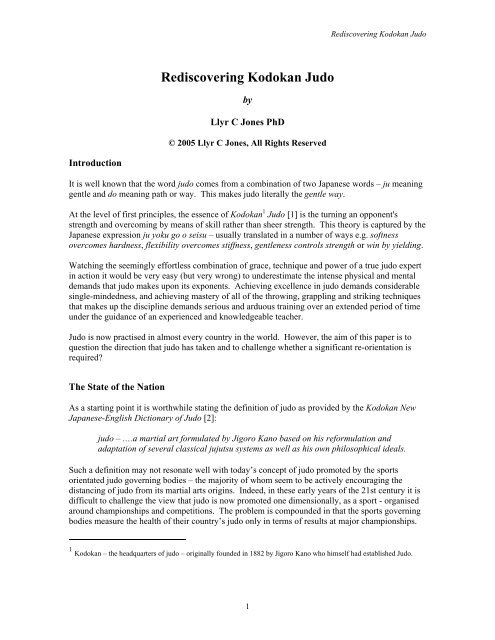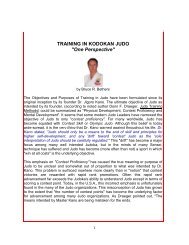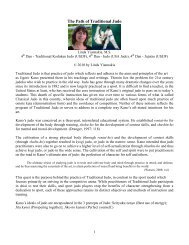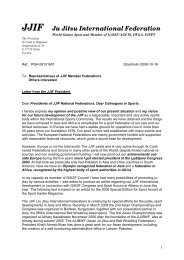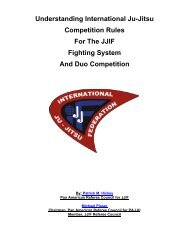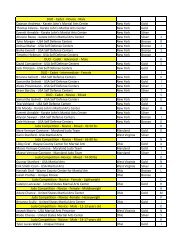Rediscovering Kodokan Judo - United States Ju-Jitsu Federation
Rediscovering Kodokan Judo - United States Ju-Jitsu Federation
Rediscovering Kodokan Judo - United States Ju-Jitsu Federation
You also want an ePaper? Increase the reach of your titles
YUMPU automatically turns print PDFs into web optimized ePapers that Google loves.
<strong>Rediscovering</strong> <strong>Kodokan</strong> <strong><strong>Ju</strong>do</strong><br />
<strong>Rediscovering</strong> <strong>Kodokan</strong> <strong><strong>Ju</strong>do</strong><br />
by<br />
Llyr C Jones PhD<br />
© 2005 Llyr C Jones, All Rights Reserved<br />
Introduction<br />
It is well known that the word judo comes from a combination of two Japanese words – ju meaning<br />
gentle and do meaning path or way. This makes judo literally the gentle way.<br />
At the level of first principles, the essence of <strong>Kodokan</strong> 1 <strong><strong>Ju</strong>do</strong> [1] is the turning an opponent's<br />
strength and overcoming by means of skill rather than sheer strength. This theory is captured by the<br />
Japanese expression ju yoku go o seisu – usually translated in a number of ways e.g. softness<br />
overcomes hardness, flexibility overcomes stiffness, gentleness controls strength or win by yielding.<br />
Watching the seemingly effortless combination of grace, technique and power of a true judo expert<br />
in action it would be very easy (but very wrong) to underestimate the intense physical and mental<br />
demands that judo makes upon its exponents. Achieving excellence in judo demands considerable<br />
single-mindedness, and achieving mastery of all of the throwing, grappling and striking techniques<br />
that makes up the discipline demands serious and arduous training over an extended period of time<br />
under the guidance of an experienced and knowledgeable teacher.<br />
<strong><strong>Ju</strong>do</strong> is now practised in almost every country in the world. However, the aim of this paper is to<br />
question the direction that judo has taken and to challenge whether a significant re-orientation is<br />
required?<br />
The State of the Nation<br />
As a starting point it is worthwhile stating the definition of judo as provided by the <strong>Kodokan</strong> New<br />
Japanese-English Dictionary of <strong><strong>Ju</strong>do</strong> [2]:<br />
judo – ….a martial art formulated by Jigoro Kano based on his reformulation and<br />
adaptation of several classical jujutsu systems as well as his own philosophical ideals.<br />
Such a definition may not resonate well with today’s concept of judo promoted by the sports<br />
orientated judo governing bodies – the majority of whom seem to be actively encouraging the<br />
distancing of judo from its martial arts origins. Indeed, in these early years of the 21st century it is<br />
difficult to challenge the view that judo is now promoted one dimensionally, as a sport - organised<br />
around championships and competitions. The problem is compounded in that the sports governing<br />
bodies measure the health of their country’s judo only in terms of results at major championships.<br />
1 <strong>Kodokan</strong> – the headquarters of judo – originally founded in 1882 by Jigoro Kano who himself had established <strong><strong>Ju</strong>do</strong>.<br />
1
<strong>Rediscovering</strong> <strong>Kodokan</strong> <strong><strong>Ju</strong>do</strong><br />
A direct consequence of this is that the governing bodies focus their investment only on the handful<br />
of elite athletes who have the potential to be World or Olympic medallists.<br />
For the majority of judoka, judo is now just about medals and prizes and most focus their attention<br />
on only the small subset of judo that is relevant to the sports competition context - thereby ignoring<br />
the other elements of judo such as atemi waza (striking techniques).<br />
It is also a matter of concern that most judo governing bodies have biased overwhelmingly their<br />
rank promotion (i.e. grading) structures towards accelerating the advancement in grade of those<br />
who are successful in competition, with often only lip service being plaid to the breadth and depth<br />
of an individual’s technical judo knowledge. Bethers [3] writes:<br />
This emphasis on "Contest Proficiency" has caused the true meaning or purpose of <strong><strong>Ju</strong>do</strong> to<br />
be unclear and somewhat out of proportion to what was intended by Dr. Kano. This<br />
problem is surfaced nowhere more clearly than in "notion" that contest victories are<br />
rewarded with rapid rank promotions.<br />
Currently there is little prospect of advancement in grade for those who (through age, physical<br />
condition or personal preference) wish to practise judo as an art as opposed to a sport. This is of<br />
course with the notable exception of the promotions that governing body officials and<br />
administrators seem to receive as a matter of course. The risk one runs with such a policy is a<br />
resultant judo hierarchy that is both one-dimensional in its knowledge and skewed in its priorities.<br />
It is especially disappointing that those judoka who prefer to focus their study on the more<br />
traditional and technical aspects of judo (e.g. kata) have become tagged with the label recreational<br />
players - with an implication that they are somehow inferior to contest players and not worthy of<br />
attention and recognition.<br />
The Turning Tide<br />
There is a significant emerging awareness that sport aspects of judo have overrun what judo is all<br />
about. Yasuhiro Yamashita, arguably the greatest judo competitor the world has ever known 2<br />
writes [4]:<br />
Today there is too much of a focus on creating "champions". There is more to learn in <strong><strong>Ju</strong>do</strong><br />
then just being champion only. I would like to teach the real meaning and spirit of <strong><strong>Ju</strong>do</strong>…<br />
In formulating this view Yamashita recalls the words and influence of his mentor, Dr Shigeyoshi<br />
Matsumae [4]:<br />
“As an athlete, the goal of becoming champion is not everything in life. There are more<br />
important aspects of sports such as the diffusion of the educational aspects of judo, making<br />
many friends through judo and making a contribution to world peace through sport and<br />
judo.”<br />
2 Between October 1977 and his retirement in April 1985 Yasuhiro Yamashita won 203 consecutive judo matches. He<br />
won a gold medal at the Los Angeles Olympics and was a three-time World <strong><strong>Ju</strong>do</strong> Champion.<br />
2
<strong>Rediscovering</strong> <strong>Kodokan</strong> <strong><strong>Ju</strong>do</strong><br />
Again Bethers [3] writes on this theme:<br />
It seems that some modern <strong><strong>Ju</strong>do</strong> Leaders have narrowed the objective of <strong><strong>Ju</strong>do</strong> to only<br />
"Contest Proficiency". For many, world-wide <strong><strong>Ju</strong>do</strong> has become equated with contest<br />
proficiency. Although this belief is today wide-spread, it is the very thing that Dr. Kano<br />
warned against throughout his life. Dr. Kano stated, "<strong><strong>Ju</strong>do</strong> should only be a means to the<br />
end of skill and principles for higher self-development, and any 'drift' toward 'contest' <strong><strong>Ju</strong>do</strong><br />
as the 'sole' interpretation of <strong><strong>Ju</strong>do</strong> should be carefully regulated." This "drift" has become a<br />
major focus among many well intended <strong><strong>Ju</strong>do</strong>ka, but in the minds of many Sensei, technique<br />
has suffered and <strong><strong>Ju</strong>do</strong> has become (more often than not) a sport in which "win at all costs"<br />
is the underlying objective.<br />
Back to Basics<br />
Statistics show that today judo is an activity in decline. Therefore there is a real need for a more<br />
balanced approach to be taken whereby judo re-emphasises its traditional martial art roots. By<br />
returning to traditional <strong>Kodokan</strong> <strong><strong>Ju</strong>do</strong> the needs of everyone, with all interests in judo, can be<br />
accommodated – not just the competitors and the elite athletes.<br />
For this purpose, Traditional <strong>Kodokan</strong> <strong><strong>Ju</strong>do</strong> is defined as [5]:<br />
… simply the practice of <strong>Kodokan</strong> <strong><strong>Ju</strong>do</strong> as described in the text <strong>Kodokan</strong> <strong><strong>Ju</strong>do</strong> [1] without<br />
an overwhelming emphasis on the sport of <strong><strong>Ju</strong>do</strong>. It is about studying the history, etiquette,<br />
waza and kata of <strong>Kodokan</strong> <strong><strong>Ju</strong>do</strong> and enjoying them for what they are - knowledge, skills<br />
and a way of life based on principles taught by <strong>Kodokan</strong> <strong><strong>Ju</strong>do</strong>’s founder, Jigoro Kano.<br />
In calling for a more balanced approach it is not the author’s aim to decry the considerable merits of<br />
competitive sport judo. The author recognises that success in contest over several traditional jujitsu<br />
schools was key in establishing <strong>Kodokan</strong> <strong><strong>Ju</strong>do</strong> as an effective combat system [1] and also that the<br />
advent of sports competition was instrumental in the global proliferation of judo. Rather, it is to<br />
argue that judo based solely on sport is not judo in toto and that the over-emphasis on the<br />
competition aspects has unjustly pushed aside and undermined the original judo ideas conceived<br />
and formulated by Kano.<br />
Other writers for example, Burkland [6] support this line of reasoning.<br />
Kano’s <strong><strong>Ju</strong>do</strong><br />
Elementary research will reveal that the underlying concept of judo as envisioned by Kano was that<br />
it was to be a means of (primarily cooperative) physical and social education – in simple terms a<br />
training for life. Kano captured this principle of mutual welfare and prosperity via the maxim jita<br />
kyo ei [1].<br />
3
<strong>Rediscovering</strong> <strong>Kodokan</strong> <strong><strong>Ju</strong>do</strong><br />
Kano’s view was that success in contest (shiai 3 ) was simply a by-product of training, never the<br />
point of it [7]. As an example, Minoru Mochizuki began judo in 1912 aged just 5. Later he studied<br />
directly under Kano and also Kyuzo Mifune, the notable 10 th Dan. At 19 Mochizuki joined the<br />
<strong>Kodokan</strong> and in less than two years he was promoted to sandan (3 rd Dan) - then an outstanding<br />
achievement aged just 21. At this point Kano told him "You have the makings of a leader.... in the<br />
future you will be a top teacher here at the <strong>Kodokan</strong>”.<br />
Kano asked Mochizuki to report to him once a month concerning his training progress and to guide<br />
him concerning the true purpose of judo and the pitfalls of sports. This led to a series of meetings at<br />
which the philosophically oriented Kano attempted to stimulate the mind of the young Mochizuki<br />
who, at that time, could only think of winning tournaments.<br />
As a direct student of Kano, Mochizuki Sensei, aged then just 23, made his own perceptive<br />
observation in 1930, still apt today:<br />
One situation leading to delinquency involves a young person dropping out of his group of<br />
friends on a sports team. Some coaches are only interested in training team members in the<br />
question of winning and losing. They pay no attention to those who drop out because they<br />
are only interested in winning. In sports there is no place for the weaker or the less<br />
competent. Personally, I would rather see various sports transformed into Martial Arts, so<br />
that they become more concerned with spiritual development and the prevention of bad<br />
behaviour. They should be more concerned with developing young people who are no<br />
trouble to their parents, who get along well with their siblings, and with promoting good<br />
relations between husbands and wives.<br />
Point made earlier in this paper indicate that today’s judo is no longer aligned with Kano and<br />
Mochizuki’s original ideas - a line of reasoning supported by Smith [8]:<br />
The popularization and spread of judo has weakened Kano’s base so greatly, I see no<br />
chance of it ever recovering. <strong><strong>Ju</strong>do</strong> is now merely a jacketed wrestling sport. The<br />
competitive has ousted the cooperative.<br />
Martial vs. Art<br />
Bates [9] argues that judo has two essential components – martial and art. The martial component<br />
of judo can be related to combat through the way of the warrior (budo) - the contemporary<br />
representation of which is shiai. In preparation for contest the modern judoka focuses on the<br />
development of physical conditioning and fitness, motivation, tactics and technique for the sole<br />
purpose of securing victory. Conversely, art can be defined as technical excellence and<br />
understanding of techniques developed through repeated practice (uchi-komi and nage-komi), free<br />
practice (randori) and of course kata.<br />
<strong><strong>Ju</strong>do</strong> is of course both martial and art, but today the concept most people have of judo is martial.<br />
Martial represents but one small element of judo, yet almost without exception, most judo teachers<br />
3 It must be emphasised that the original concept of shiai was a contest (bout) whereby the efficacy of one’s<br />
judo skills were tested against an opponent. This is different to the contemporary interpretation of shiai as a<br />
sporting championship.<br />
4
<strong>Rediscovering</strong> <strong>Kodokan</strong> <strong><strong>Ju</strong>do</strong><br />
focus on developing the contest prowess of their students and many believe it unnecessary to<br />
practice or even know any kata.<br />
<strong>Rediscovering</strong> Kata<br />
Kata has a vital role to play in re-balancing judo and is a core component of any classical judo<br />
programme. In the most general sense any cooperative judo training e.g. a sequence of<br />
combinations or counters etc. between partners can be considered kata. However, a greater degree<br />
of focus is provided in [2] which defines kata as follows:<br />
kata – …Formal movement pattern exercises containing idealised model movements<br />
illustrating specific combative principles.<br />
Kata is not unique to judo – it is recognised as a valuable training drill in most of the Japanese<br />
martial arts, however the exact nature of kata training varies from art to art. For example, karate<br />
kata is a solo form (like shadow boxing) whereas the judo kata are usually performed with partner -<br />
each partner having a specific role and performance objective depending on which kata is being<br />
performed. In judo, there are kata for throwing techniques, groundwork techniques, self-defence as<br />
well as others that illustrate the fundamental principles of judo [1, 10, 11, 12, 13, 14, 15].<br />
For completeness a comprehensive list of the kata practiced in judo is now given, together with a<br />
summary description of each [15]. It is worth noting that a broad repertoire of judo techniques that<br />
have disappeared from modern sports judo continue to survive in the kata.<br />
Note that not all of these kata were created by Kano or the <strong>Kodokan</strong> and as such some are not<br />
official <strong>Kodokan</strong> Kata. Note also that the last six kata in the list are seldom practised (outside<br />
Japan) and even there, few judoka would be familiar with them.<br />
• Nage no Kata: The kata of throws. Includes examples of hand, hip, leg and sacrifice throws.<br />
• Katame no Kata: The kata of grappling. Includes examples of holds, strangles and chokes and<br />
joint locks.<br />
• Kime no Kata: The kata of decision. This is the traditional judo self-defence kata. Includes<br />
both standing and kneeling defence against empty handed, knife and sword attacks using<br />
strikes, chokes, joint locks and throws. Note that the Kime no Kata is also known as the<br />
Shinken Shobu no Kata (Combat Forms).<br />
• <strong>Kodokan</strong> Goshin <strong>Jitsu</strong>: The modern <strong>Kodokan</strong> self defence kata. Includes defence against<br />
empty hand, knife, stick (jo), and pistol attacks using strikes, joint locks and throws.<br />
• <strong>Ju</strong> no Kata: The kata of gentleness. Includes a number of attacks and defences demonstrating<br />
the efficient redirection of force and movement.<br />
• Itsutsu no Kata: The kata of five principles. This kata is intended for the demonstration and<br />
practice of body movement (tai-sabaki) and for the application and redirection of energy as in<br />
nature.<br />
5
<strong>Rediscovering</strong> <strong>Kodokan</strong> <strong><strong>Ju</strong>do</strong><br />
• Koshiki no Kata: The ancient kata. This kata has its origins in Kito-ryu jujitsu and demonstrates<br />
the techniques of kumiuchi or fighting while wearing armour (yoroi) and is intended to illustrate<br />
the ancient origins of judo techniques.<br />
• Gonosen no Kata: The kata of counters. This kata includes counter throws for a number of<br />
common techniques.<br />
• Kaeshi no Kata: An alternative kata of counters.<br />
• Nage-Ura no Kata: Another kata of counters due to Kyuzo Mifune.<br />
• Seiryoku-Zenyo Kokumin-Taiiku: The national exercise based on the principles of maximum<br />
efficiency. This kata is atypical of judo in being a completely solo kata and comprises of a<br />
variety of striking and kicking techniques.<br />
• <strong>Kodokan</strong> Joshi Goshin-Ho: The <strong>Kodokan</strong>’s women's judo self defence kata. This kata<br />
includes a number of escapes from holds and grabs, some basic striking techniques and one<br />
throw.<br />
• Renkoho: The kata of arresting techniques. This kata includes a number of control and<br />
submission holds useful in restraining criminals.<br />
• Kimi-Shiki: The kata of decision. This kata emphasises the use of body movement in<br />
responding to attacks and includes both kneeling and standing defences against empty hand,<br />
knife and sword attacks<br />
• Shobu no Kata: The kata of attack or contest.<br />
• Go no Kata: The kata of force or blows. This kata includes a variety of atemi-waza or striking<br />
techniques.<br />
In nearly all of the martial arts kata is used as a training tool from the novice stage upwards.<br />
However, in judo its significance has long been under-emphasised and kata practice is now largely<br />
confined to very high grades or those who are not contest-inclined. It is a tragedy of modern judo<br />
that in the headlong rush into Olympic-type competition most dan grades regard kata as an<br />
anachronism (of little relevance to competition) that should be discarded. The late Charles Palmer<br />
(then President of the British <strong><strong>Ju</strong>do</strong> Association) anticipated this situation when he wrote his 1982<br />
foreword to Leggett (and Kano’s) kata text [11]:<br />
…too much emphasis is being placed on winning at all costs. Not enough time is being<br />
spent by <strong><strong>Ju</strong>do</strong> players on acquiring the vital self-discipline necessary to proper<br />
performance of the sport, and the ability to continue enjoying it later in life after the ability<br />
to win contests has decreased.<br />
It was particularly insightful of Palmer to recognise that Performance <strong><strong>Ju</strong>do</strong> is age limited. Such<br />
sport judo is the domain of the young whereas <strong>Kodokan</strong> <strong><strong>Ju</strong>do</strong> (especially kata) can be done up until<br />
a very advanced age.<br />
6
<strong>Rediscovering</strong> <strong>Kodokan</strong> <strong><strong>Ju</strong>do</strong><br />
A direct consequence of kata not being part of the normal activity of most judo clubs is that the<br />
availability of people with the required knowledge and teaching skills is very limited. In the early<br />
years of the 21 st century judo even some of the better known judo kata are in serious danger of<br />
becoming extinct as the opportunities to learn and benefit from their practice have become quite<br />
rare.<br />
The Importance of Kata<br />
To gain a true understanding of judo as envisioned by Kano it is necessary to look beyond<br />
competition to kata. This author believes that the link between judo’s past and future is embodied<br />
in the accurate teaching of kata for it is only in kata that the totality of judo has been preserved.<br />
Kano identified two types of training for judo – kata and randori and held the firm belief that the<br />
two training system had to co-exist in parallel. Kano envisaged kata being the laboratory for judo<br />
development and randori as the testing ground [10].<br />
In particular, Kano developed kata to demonstrate the principles of judo and to provide a type of<br />
training in which students could examine techniques under ideal circumstances – thus penetrating<br />
their very essence.<br />
Through repeated practice, the techniques of the various kata can be performed without thinking<br />
and, in the extreme, kata can unify mind, body and spirit – arguably the purest goal of a martial art.<br />
Indeed many judoka claim to have experienced moments of enlightenment and insight as a result of<br />
a perfect kata performance. Notwithstanding the subjective spiritual dimension it is certainly true<br />
that both judoka involved can derive a great deal of self-satisfaction from a high quality kata<br />
performance and the associated focus, awareness, attention to detail and self-discipline demanded.<br />
Furthermore, students and teachers should also not overlook the significance of kata as purely a part<br />
of general instruction as kata teaches movement, timing and coordination. Kata was, and remains<br />
the basis of judo, and provides the vehicle for perfecting many throws, holds and other techniques<br />
in a finer way than individual technical instruction or general randori.<br />
Critics of kata argue that kata bears very little resemblance to shiai in that the techniques are<br />
performed at a standard pace with a pre-determined outcome in an overly symbolised style.<br />
However, it is unlikely to be widely known that most high-grade Japanese teachers still emphasise<br />
the importance of kata for a judoka’s development and that many consider the study of the Randori<br />
no Kata (Nage no Kata and Katame no Kata) in particular to be an essential part of training for the<br />
highest level of contest success [10, 12].<br />
In their seminal text <strong><strong>Ju</strong>do</strong> Formal Techniques Otaki and Draeger [10] state that:<br />
Sufficient kata study and practice impose a well-defined technical discipline on the judoist,<br />
one that is unattainable by only randori and contest methods. This discipline, instead of<br />
hampering the judoist, actually frees him from undue restrictions, liberates his bodily<br />
expression in movement, and teaches him economy of mental and physical energy. This<br />
process can only be understood through experience, and only through kata performance<br />
can judoists come to appreciate <strong><strong>Ju</strong>do</strong> in its fullest sense.<br />
7
<strong>Rediscovering</strong> <strong>Kodokan</strong> <strong><strong>Ju</strong>do</strong><br />
The point is reinforced by Kawaishi [12] who wrote:<br />
The Kata will temper the combative ardour of the young performer and will undoubtedly<br />
also enable him to discover the reason for certain errors he commits in competition…Thus<br />
the Kata is a valuable source of technical progress.<br />
Accordingly, the contest player should consider kata as part of his training for physical, mental and<br />
contest proficiency in an identical fashion to randori and conditioning work etc.<br />
Conclusions and the Way Ahead<br />
Given the substantial decline in the number of adults practising judo it can be argued that there is a<br />
real need to re-examine the value system associated with judo. A way must be found to retain and<br />
ideally attract more adults into judo. As part of this exercise the emphasis between the martial and<br />
art strands of judo should be examined simultaneously because the two strands should not be<br />
separated. .<br />
Metaphorically one can argue that judo is like a cake - you can not make it without all the<br />
ingredients and no one ingredient is more important than the other. Extreme polarization in either<br />
the direction of shiai (or the direction of kata) is unbalanced and will result in a destructive division<br />
of judo. The conclusions of Burkland [6] are particularly relevant:<br />
<strong><strong>Ju</strong>do</strong> must focus on its heritage as a traditional martial way by emphasising randori and<br />
kata as the primary training vehicles for the development…. Shiai must be returned to its<br />
proper perspective and cannot be allowed to dominate our thinking and our efforts.<br />
Recognition should also be given to the arguments of Gleeson [16]. Gleeson showed that there was<br />
a close connection between the three dimensions of judo and argued that randori, shiai and kata<br />
were all essential to each other. Gleeson recognised that through ignorance and neglect, artificial<br />
boundaries had been built between the dimensions, preventing people moving easily from one to<br />
another. Gleeson also acknowledged the need to deconstruct these boundaries for judo to prosper.<br />
A similar idea has been expressed metaphorically by relating judo to a three-legged stool [17] - the<br />
three legs being randori, shiai and kata. The metaphor proceeds to argue that if any one leg is<br />
removed, the stool falls over. This can be directly interpreted that without equal emphasis in all<br />
three elements judo will be flawed. The interested reader requiring a further perspective on<br />
<strong>Kodokan</strong> <strong><strong>Ju</strong>do</strong> - including the introduction of a concept of four overlapping areas for study (i.e.<br />
physical education; sport; unarmed combat and philosophy) is also directed to the contribution of<br />
Anderson [18].<br />
Additionally implicit in the re-evaluation of judo’s value structure is a real need to reassess and<br />
reformulate the promotion system. In doing so a fundamental tenet of Kano’s philosophy should be<br />
to the fore:<br />
It's not that you are better than someone else that's important but that you are better than<br />
you were yesterday."<br />
8
<strong>Rediscovering</strong> <strong>Kodokan</strong> <strong><strong>Ju</strong>do</strong><br />
The principles expounded in this paper are already starting to come to the fore with the emergence<br />
of the Martial Arts International <strong>Federation</strong>’s International Traditional <strong>Kodokan</strong> <strong><strong>Ju</strong>do</strong> (ITKJ)<br />
programme [19], which does not have an overwhelming emphasis on the sport of judo.<br />
To conclude, judo today faces a crisis no different to that facing Jigoro Kano in 1882 when he<br />
founded judo from jujutsu. In evolving judo from jujitsu, Kano endeavoured to preserve the<br />
fundamental elements of jujitsu lest they be lost forever. Today, the ITKJ is taking similarly radical<br />
steps to re-establish and preserve the heritage, traditions, techniques and kata of judo that were the<br />
true genius of Kano.<br />
A version of this article first appeared in the Journal of Asian Martial Arts, Volume 14,<br />
Number 3, 2005 – published under the title Competition, Kata and the Art of <strong><strong>Ju</strong>do</strong><br />
References<br />
1. Kano, J, 1986, <strong>Kodokan</strong> <strong><strong>Ju</strong>do</strong>, Kodansha International, Tokyo, Japan<br />
2. Kawamura, T and Daigo, T, 2000, <strong>Kodokan</strong> New Japanese-English Dictionary of <strong><strong>Ju</strong>do</strong>,<br />
<strong>Kodokan</strong> Institute, Tokyo, Japan.<br />
3. Bethers, B R, Training in <strong>Kodokan</strong> <strong><strong>Ju</strong>do</strong> – “One Perspective”, Martial Arts International<br />
<strong>Federation</strong> (MAIF) Traditional <strong>Kodokan</strong> <strong><strong>Ju</strong>do</strong> Program,<br />
http://www.maintlfed.org/resources/kodokan.html<br />
4. International <strong><strong>Ju</strong>do</strong> <strong>Federation</strong>, 2003, <strong><strong>Ju</strong>do</strong> Star - Interview with Mr. Yashuhiro Yamashita,<br />
Tokyo, http://www.ijf.org/corner/qStarView.php?Page=1&MenuCode=JS&Idx=75<br />
5. International Traditional <strong>Kodokan</strong> <strong><strong>Ju</strong>do</strong> Website, 2005, What is Traditional <strong><strong>Ju</strong>do</strong>?<br />
http://www.itkj.org/whatistkj.html<br />
6. Burkland, R A, 1998, <strong><strong>Ju</strong>do</strong>: Martial Way or Modern Sport, Shudokan Martial Arts Association<br />
Newsletter - Spring 1998, http://www.michionline.org/smaa/articles/burkland_judo.html<br />
7. Mid Sussex Martial Arts School, http://www.msmas.org/<br />
8. Smith, R W, 1999, Martial Musings, Via Media Publishing Company, Erie, Pennsylvania,<br />
USA.<br />
9. Bates, A C, Classical <strong><strong>Ju</strong>do</strong> – Time to Realise, in Tokushima Budo Council Official Bulletin,<br />
No. 79.<br />
10. Otaki, T and Draeger, 1983, D F, <strong><strong>Ju</strong>do</strong> Formal Techniques, Charles E Tuttle Company<br />
Incorporated, Tokyo, Japan.<br />
11. Leggett, T P and Kano, J, 1982, Kata <strong><strong>Ju</strong>do</strong>, W Foulsham & Company Limited, Slough,<br />
Berkshire, UK.<br />
9
<strong>Rediscovering</strong> <strong>Kodokan</strong> <strong><strong>Ju</strong>do</strong><br />
12. Kawaisihi, M, 1982, The Complete 7 Katas of <strong><strong>Ju</strong>do</strong>, The Overlook Press, Woodstock, New<br />
York, USA.<br />
13. Fromm, A and Soames, N, 1982, <strong><strong>Ju</strong>do</strong> – The Gentle Way, Routledge & Kegan Paul, London,<br />
UK.<br />
14. Mifune, K (White, F – Translator), 2005 – new revised edition, The Canon of <strong><strong>Ju</strong>do</strong> - Classic<br />
Teachings on Principles and Techniques, Kodansha International, Tokyo, Japan.<br />
15. Ohlenkamp, N, 1995/2004, <strong><strong>Ju</strong>do</strong> Information Site - Forms of <strong><strong>Ju</strong>do</strong> (Kata),<br />
http://judoinfo.com/katamenu.htm<br />
16. Gleeson, G R, 1976, The Complete Book of <strong><strong>Ju</strong>do</strong>, Coles Publishing Company Limited<br />
17. Kin Ryu <strong><strong>Ju</strong>do</strong> Club Website, The Basics of <strong><strong>Ju</strong>do</strong>. http://www.kinryu.org.uk/judobasics.htm<br />
18. Anderson, V, The Four Pillars of <strong><strong>Ju</strong>do</strong>, Fighting Arts Website,<br />
http://www.fightingarts.com/reading/article.php?id=146<br />
19. International Traditional <strong>Kodokan</strong> <strong><strong>Ju</strong>do</strong> Website, 2005. http://www.itkj.org/<br />
10


